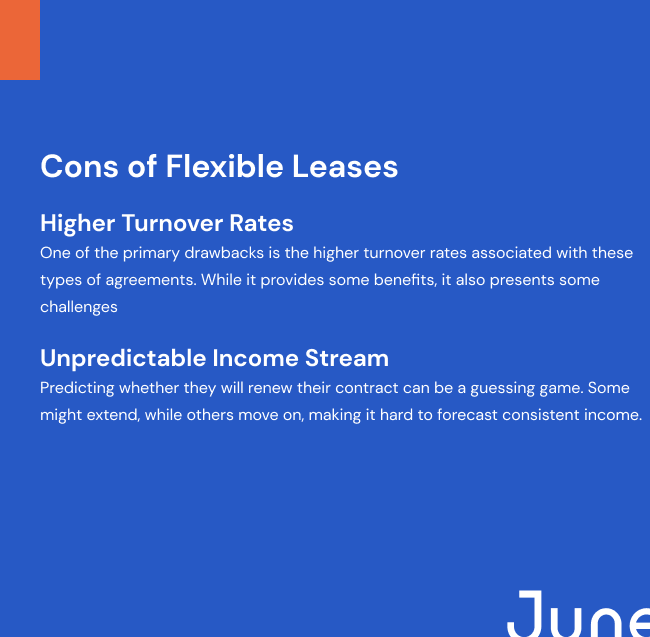
Estimated reading time: 6 minutes
A flexible lease is a rental agreement that does not strictly adhere to the traditional fixed-term durations, often allowing both landlords and tenants greater adaptability.
The concept isn’t entirely new, but in recent years, the popularity of such leases has skyrocketed. Various factors, from economic shifts to individual lifestyle changes, have played a role in this uptick. Now, the pros and cons of flexible leases have become a focal point of discussion in real estate circles.
For homeowners, the appeal lies in the possibility of greater adaptability, potential financial advantages, and a more dynamic tenant-landlord relationship. While these leases open up many opportunities, they also come with a set of challenges. Homeowners must weigh these factors before deciding on the best path forward.
Table of contents
The Upside

Pro #1 – Adaptability in Changing Times
Flexible leases offer a vital advantage: adaptability. Unlike traditional 12-month or multi-year leases, these shorter-term agreements allow homeowners to respond more agilely to various changes. Whether it’s a sudden job relocation, family emergency, or economic downturn, a flexible lease gives you the freedom to make quick decisions without the burden of long-term commitments.
Another notable benefit lies in tenant diversity. Without a year-long contract, you can attract a broad range of renters, from business travelers to students or seasonal workers. This variety adds to the vibrancy of your property and enhances your networking opportunities and mouth-to-mouth marketing of your rental property. Plus, having a diverse tenant pool means you can fill vacancies quicker, making the most out of every rental period.
Pro #2 – Financial Flexibility
Balancing the financial aspects of property management can be a tightrope walk. However, one of the clear advantages is the financial freedom it offers. Traditional leases often lock in a set rate, which means missing out on potential income spikes during high-demand seasons. Without being tethered to a fixed rental rate for an entire year, homeowners have the opportunity to adjust prices accordingly.
Consider a city that attracts a massive influx of tourists or business professionals during certain times of the year. By embracing a flexible lease, homeowners position themselves for success, leveraging the opportunity to raise rental rates during these peak periods and aligning their earnings with the heightened demand.
Of course, this strategy requires keen market awareness. Monitoring rental trends and staying updated on events or conventions in the area can help set the right price at the right time. The rewards can be substantial for those willing to put in the effort.
Pro #3 – Easier Property Upgrades
The regular change in occupancy has an unexpected upside: it provides homeowners with consistent opportunities to assess their property’s state. Each time a tenant moves out, homeowners can pinpoint areas that need attention or enhancement.
Minor upgrades can make a massive difference in a property’s appeal. Think of fresh coats of paint, updated fixtures, or revamped outdoor spaces. By continuously making these small changes, homeowners can justify increased rental rates, leading to a better return on investment.
Additionally, a well-maintained and upgraded property is an appealing bait for prospective renters. Along with some criteria you should follow when choosing a tenant for your property, an updated and attractive living space will bring you high-quality tenants willing to pay a premium price for these features in no time. After all, every renter is looking for a well-kept space that offers value for their money.
The Downside

Con #1 – Higher Turnover Rates
While it might seem like the perfect strategy for many, addressing the full spectrum of the pros and cons is essential. One of the primary drawbacks is the higher turnover rates associated with these types of agreements. While it provides some benefits, it also presents some challenges:
- The greater administrative workload for homeowners: People frequently come and go, and homeowners must constantly handle lease agreements, move-in and move-out inspections, and other administrative tasks. This continuous cycle can be draining and time-consuming.
- Increased wear and tear: A property sees more activity with frequent changes. This constant transition can accelerate property wear and tear, from moving furniture to general usage, potentially leading to more frequent repairs.
- Need for regular marketing and tenant screening: Unlike longer-term leases, where the property is off the market for extended periods, flexible leases necessitate consistent marketing efforts. Furthermore, tenant screening becomes a recurrent task, demanding diligence to ensure quality renters occupy the space.
Con #2 – Unpredictable Income Stream
You can’t expect high demand for rental spaces at every time of the year. There might be months where the influx of tenants dwindles, leading to decreased or even absent rental income.
Predicting whether they will renew their contract can be a guessing game. Some might extend, while others move on, making it hard to forecast consistent income.
Because of the uncertainties, homeowners should consider setting aside a financial reserve. It will buffer any unforeseen expenses or mortgage commitments, even during lean months.
Being prepared for these income fluctuations is vital. Homeowners should plan meticulously, keeping these potential challenges in mind, maximizing the benefits while maintaining a steady financial foothold.
Tips on Navigating the Pros and Cons of Flexible Leases
To boost benefits and minimize pitfalls, here are some actionable tips for homeowners:
- Ensure a solid lease agreement: Draft a comprehensive lease that covers all potential scenarios. Articulate every detail to prevent future disputes, from early terminations to asset maintenance, ensuring you maximize profits.
- Set clear expectations and guidelines: Beyond the lease, provide tenants with a transparent list of do’s and don’ts. This clarity helps maintain the property’s condition and fosters a harmonious landlord-tenant relationship.
- Establishing good communication with tenants: Open communication channels can solve many potential problems. Regular check-ins, through monthly emails or quarterly visits, can keep both parties aligned and informed.
- Leveraging technology for tenant management: Use modern property management software to streamline processes like rent collection, maintenance requests, and lease renewals. These tools reduce the administrative burden and enhance the overall leasing experience.
Final Thoughts
Navigating the pros and cons of flexible leases is no small feat. Before deciding, you should weigh individual circumstances and long-term goals. The rental market’s current conditions should also influence your choice. Remember, the real estate world is ever-evolving. Staying informed and adaptable ensures you make choices that align with your property’s potential and financial aspirations. In the end, flexible leasing might be the perfect fit for some, while others might find solace in traditional arrangements. The key is to assess, decide, and act with clarity.
Find Flexible Leases With June Homes
If you’re planning a move, finding the right accommodation should be your top priority. June Homes is here to help you find an apartment or studio for rent that fits your needs and preferences. Whether you’re looking for studio apartments, short terms rentals, shared homes, or any other type of rental, we’re here to assist you.